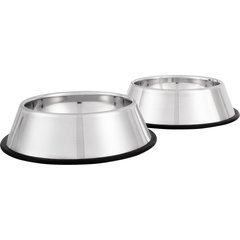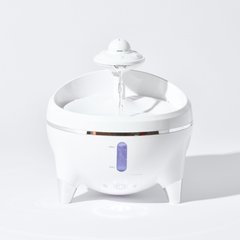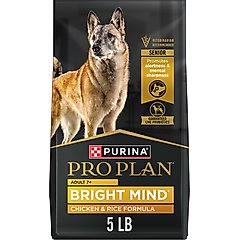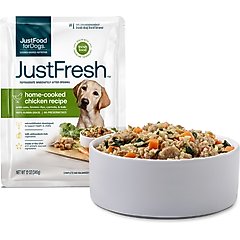The Ultimate Guide to Dog Food Ingredients

Photo by Chewy
Dogs are omnivores who require 40 essential nutrients, divided into six nutrient groups. A complete and balanced dog food should contain all of these key nutrient groups. But with countless food options to choose from, how can you make sure your BFF is getting adequate nutrition?
We talked with experts to learn more about dog food ingredients—including what to look for (and what to avoid) when selecting a high-quality dog food—plus a few balanced and complete options to try.
Speak with your veterinarian before changing your dog’s diet.
Key Takeaways
- A high-quality, healthy dog food should contain a balanced combination of ingredients, such as proteins, carbohydrates, fats, fiber, vitamins, and minerals.
- Some dog food ingredients to avoid include fillers and artificial additives.
- You can identify complete and balanced dog foods by checking the packaging for the Association of American Feed Control Officials (AAFCO) nutritional adequacy statement on the label.
- It’s always best to consult your veterinarian to learn more about essential dog food nutrients and personalized recommendations for your dog’s individual needs.
6 Dog Food Ingredients Every Pup Needs
Dogs need a balanced diet consisting of an appropriately portioned mix of nutrients to stay healthy. Understanding what each key ingredient does and how it benefits dogs is crucial to meet your pup’s specific nutritional needs.
Here are the most important dog food ingredients to look for, according to the AAFCO:
1. Proteins
Proteins are the most essential building blocks for your dog’s body, says Sabrina Kong, DVM, certified canine rehabilitation practitioner at Jules Veterinary Center, in Tracy, California.
There are both animal- and plant-based sources of protein for dogs. High-quality, animal-based proteins have a high bioavailability, meaning your dog’s body can absorb and use them efficiently. Compared to absorbing meat-based proteins, dogs can absorb only about half of the nutritional value of plant-based proteins, she explains.
Examples of protein sources include:
Protein supplies all the amino acids that support the body functions for muscles, skin and coat, immune system, organs and tissues, and enzymes and hormones, says Randy Aronson, VMD, CCRT, CVA, veterinarian and founder of PAWS Veterinary Center, in Tucson, Arizona.
2. Carbohydrates
Carbohydrates are energy powerhouses that are broken down into glucose, serving as your dog’s primary source of fuel, Dr. Kong says.
Some examples of carbohydrates include:
- Sweet potatoes (rich in fiber)
- Oats (gentle on sensitive stomachs)
- Blueberries (provide low-glycemic antioxidants)
Carbohydrates help support a dog’s activity level and healthy digestion. Dogs require carbohydrates during growth, gestation, and lactation because their energy needs are higher, according to the Merck Veterinary Manual.
3. Fats
Fats are made up of fatty acids that are a vital source of energy and help in the absorption of the fat-soluble vitamins A, D, E, and K, says Dr. Aronson.
Fats can be animal-based and plant-based. Examples of fat sources include:
- Salmon oil
- Beef or pork fat
- Chicken fat
- Fish oil
- Egg yolk
- Flaxseed or flaxseed oil
- Coconut oil
- Canola oil
- Sunflower oil
Fats are crucial for providing your dog with concentrated energy, more than double what they get from carbohydrates or protein, and are also important for brain health, Dr. Kong says.
She recommends prioritizing omega fatty acids for your dog, specifically omega-3 fatty acids to help reduce inflammation and omega-6 fatty acids for promoting healthy skin and a shiny coat.
4. Fiber
Fiber is key to a healthy gut. It’s the indigestible part of plants that will pass through a dog’s gastrointestinal tract and plays a vital role in digestive and overall health, Dr. Aronson says.
Fiber is found in fruits, legumes, grains, and vegetables. Two forms of fiber found in dog foods include:
- Soluble fiber: Helps soothe diarrhea and can be found in sources such as beet pulp, chicory root, oats, psyllium husks, apples, carrots, and sweet potatoes
- Insoluble fiber: Great for combating constipation and can be found in sources such as wheat bran, pumpkin, cellulose, green beans, celery, and beet pulp
Not only does fiber aid digestion, but it also helps stabilize blood sugar, Dr. Kong says. She recommends probiotic fibers from chicory root for senior dogs to help nourish healthy gut microbes.
5. Vitamins and Minerals
“Vitamins and minerals are tiny nutrients that play a huge role, as they orchestrate a wide variety of bodily functions,” Dr. Kong says.
A few examples of vitamins and minerals include:
- Zinc: Boosts skin and coat health; found in beef and eggs
- Vitamin E: Helps fight inflammation; found in fish oil and spinach
- Calcium: Essential for building strong bones; found in yogurt and broccoli
Whole-food sources for these micronutrients include:
- Liver (vitamin A)
- Sardines (vitamin D)
- Pumpkin (iron)
6. Water
Water is vital for dogs; it supports several physiological functions. Dogs should always have access to fresh, clean water to stay hydrated and healthy.
Generally, dogs need about 1 ounce of water per pound of body weight every day. However, this can vary depending on factors such as their diet, activity level, and health status.
Something to keep in mind is that a dog’s water content can change depending on their age:
- Puppies and young dogs: About 70–80% of their body weight
- Adult dogs: Roughly 60% of their body weight
- Senior dogs: Around 50–55% of their body weight
You can help your dog drink more water by offering multiple water sources and even playing water games.
Recommended Products
5 Dog Food Ingredients To Avoid
It’s just as important to know what ingredients to avoid in dog food. According to Dr. Kong, key ingredients to steer clear of when choosing a dog food include:
- Fillers, such as corn syrup, soy, and any generic meat by-products: These kinds of ingredients have very low digestibility for dogs.
- Artificial additives: Additives such as BHA (butylated hydroxyanisole) and BHT (butylated hydroxytoluene) are used to preserve dog food. While research is limited, these artificial additives have been linked to cancer in rats.
- Generic animal fat: This is often lower-quality rendered fat. Instead, look for ingredients that clearly state the source of the fat, such as “beef fat” or “chicken fat.”
- Excess salt and sugar: These can be hidden in various “flavor enhancers.”
- Plant protein blends: Foods that use these as their primary source can lack amino acids like taurine; taurine deficiency has been linked to heart disease in some grain-free diets.
When in doubt, look for whole, recognizable ingredients and consult your vet for personalized guidance.
The Best Complete and Balanced Dog Foods
When choosing the best high-quality dog food for your canine companion, ensure it’s appropriate for your dog’s life stage.
Dr. Kong recommends the following complete and balanced dog foods for your dog to try:
- For puppies: Brands like Royal Canin offer breed-specific formulas with DHA for brain development.
- For adults: Hill’s Science Diet Adult is a great option with a balanced mix of animal protein and fiber, and it contains clinically proven antioxidants.
Recommended Product
- For seniors: Purina Pro Plan Bright Mind is enhanced with botanical oils to support cognitive function, along with glucosamine for joint health.
Recommended Product
- Overall: JustFoodForDogs JustFresh offers human-grade, kitchen-prepared meals with vet-formulated nutrition and is an overall premium choice.
Recommended Product
“Remember, no single food is perfect for every dog,” Dr. Kong says. “I recommend rotating proteins every quarter—as long as your dog tolerates it well—to prevent sensitivities and ensure a broader intake of nutrients.”
Whenever you switch your pup’s food, gradually transition to the new food over seven to 10 days to prevent potential issues like upset stomach and nausea.
FAQs About Dog Food Ingredients
What’s the first ingredient I should look for in dog food?
The first ingredient to look for in dog food is a whole protein—not a meal or fat, Dr. Aronson says. Check the packaging for the AAFCO certification that the food is for maintenance or all life stages rather than for intermittent or supplemental feeding.
What’s the most common dog food ingredient?
Chicken is the most common dog food ingredient.
“It’s affordable, and dogs tend to find it very palatable—however, it’s also one of the top allergens for dogs,” Dr. Kong says. “If your dog starts showing symptoms of a food sensitivity, such as excessive itching or ear infections, you should consider switching to a novel protein, like duck or bison, to see if the symptoms improve.”
Can certain breeds have ingredient allergies?
Possibly. Any dog breed can have ingredient allergies, but some breeds, such as West Highland White Terriers, Cocker Spaniels, and Labrador Retrievers, may be predisposed to developing food allergies, according to the Merck Veterinary Manual.
What does “human-grade” mean in dog food?
The “human-grade” label in dog food means that the ingredients and the facility where the food was made meet the FDA’s standards for human consumption, Dr. Kong says. However, you should still check for the AAFCO certification on the packaging to ensure it’s nutritionally complete for dogs.
How do I read and understand a dog food label?
When you’re reading a dog food label, keep in mind that the ingredients are listed by weight in descending order.
To ensure you’re choosing a high-quality, balanced and complete dog food, Dr. Kong recommends starting with the first ingredient. This should be a named animal protein, such as “chicken,” “salmon,” or “lamb,” rather than a vague term like “meat meal.”
Ultimately, the most important thing to look for is the AAFCO statement, which confirms the food is complete and balanced for your dog’s specific life stage, Dr. Kong says.








